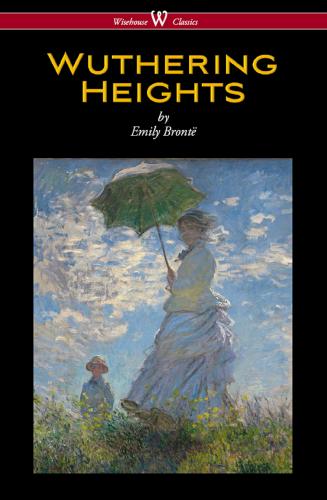Wuthering Heights (Wisehouse Classics Edition). Emily Bronte
Wuthering Heights
Wuthering Heights
by
Emily Brontë
W
Wisehouse Classics
Emily Brontë
Wuthering Heights
Cover painting: Claude Monet (1840-1926) - Woman with a Parasol - Madame Monet and Her Son (1875) – Oil on canvas.
Illustration on page 9: Wuthering Heights family tree. Using PD-Art reproductions of 18-19th-century British portraits of unknown people (2013) – by Shakko - Wikimedia
Executive Editor Sam Vaseghi
Published by Wisehouse Classics – Sweden
ISBN 978-91-7637-182-4
Wisehouse Classics is a Wisehouse Imprint.
© Wisehouse 2016 – Sweden
© Without limiting the rights under copyright reserved above, no part of this publication may be reproduced, stored in or introduced into a retrieval system, or transmitted, in any form or by any means (electronic, mechanical, photographing, recording or otherwise), without the prior written permission of the publisher.
Contents
BIOGRAPHICAL NOTICE OF ELLIS AND ACTON BELL
CHAPTER 10
CHAPTER 11
CHAPTER 12
CHAPTER 13
CHAPTER 14
CHAPTER 15
CHAPTER 16
CHAPTER 17
CHAPTER 18
CHAPTER 19
CHAPTER 20
CHAPTER 21
CHAPTER 22
CHAPTER 23
CHAPTER 24
CHAPTER 25
CHAPTER 26
CHAPTER 27
CHAPTER 28
CHAPTER 29
CHAPTER 30
CHAPTER 31
CHAPTER 32
CHAPTER 33
CHAPTER 34
BIOGRAPHICAL NOTICE OF ELLIS AND ACTON BELL
IT HAS BEEN THOUGHT THAT ALL THE WORKS PUBLISHED UNDER THE NAMES of Currer, Ellis, and Acton Bell, were, in reality, the production of one person. This mistake I endeavoured to rectify by a few words of disclaimer prefixed to the third edition of “Jane Eyre.” These, too, it appears, failed to gain general credence, and now, on the occasion of a reprint of “Wuthering Heights” I am advised distinctly to state how the case really stands.
Indeed, I feel myself that it is time the obscurity attending those two names— Ellis and Acton—was done away. The little mystery, which formerly yielded some harmless pleasure, has lost its interest; circumstances are changed. It becomes, then, my duty to explain briefly the origin and authorship of the books written by Currer, Ellis, and Acton Bell.
About five years ago, my two sisters and myself, after a somewhat prolonged period of separation, found ourselves reunited, and at home. Resident in a remote district, where education had made little progress, and where, consequently, there was no inducement to seek social intercourse beyond our own domestic circle, we were wholly dependent on ourselves and each other, on books and study, for the enjoyments and occupations of life. The highest stimulus, as well as the liveliest pleasure we had known from childhood upwards, lay in attempts at literary composition; formerly we used to show each other what we wrote, but of late years this habit of communication and consultation had been discontinued; hence it ensued, that we were mutually ignorant of the progress we might respectively have made.
One day, in the autumn of 1845, I accidentally lighted on a Ms. volume of verse in my sister Emily’s handwriting. Of course, I was not surprised, knowing that she could and did write verse: I looked it over, and something more than surprise seized me—a deep conviction that these were not common effusions, nor at all like the poetry women generally write. I thought them condensed and terse, vigorous and genuine. To my ear, they had also a peculiar music—wild, melancholy, and elevating.
My sister Emily was not a person of demonstrative character, nor one on the recesses of whose mind and feelings, even those nearest and dearest to her could, with impunity, intrude unlicensed; it took hours to reconcile her to the discovery I had made, and days to persuade her that such poems merited publication. I knew, however, that a mind like hers could not be without some latent spark of honourable ambition, and refused to be discouraged in my attempts to fan that spark to flame.
Meantime, my younger sister quietly produced some of her own
